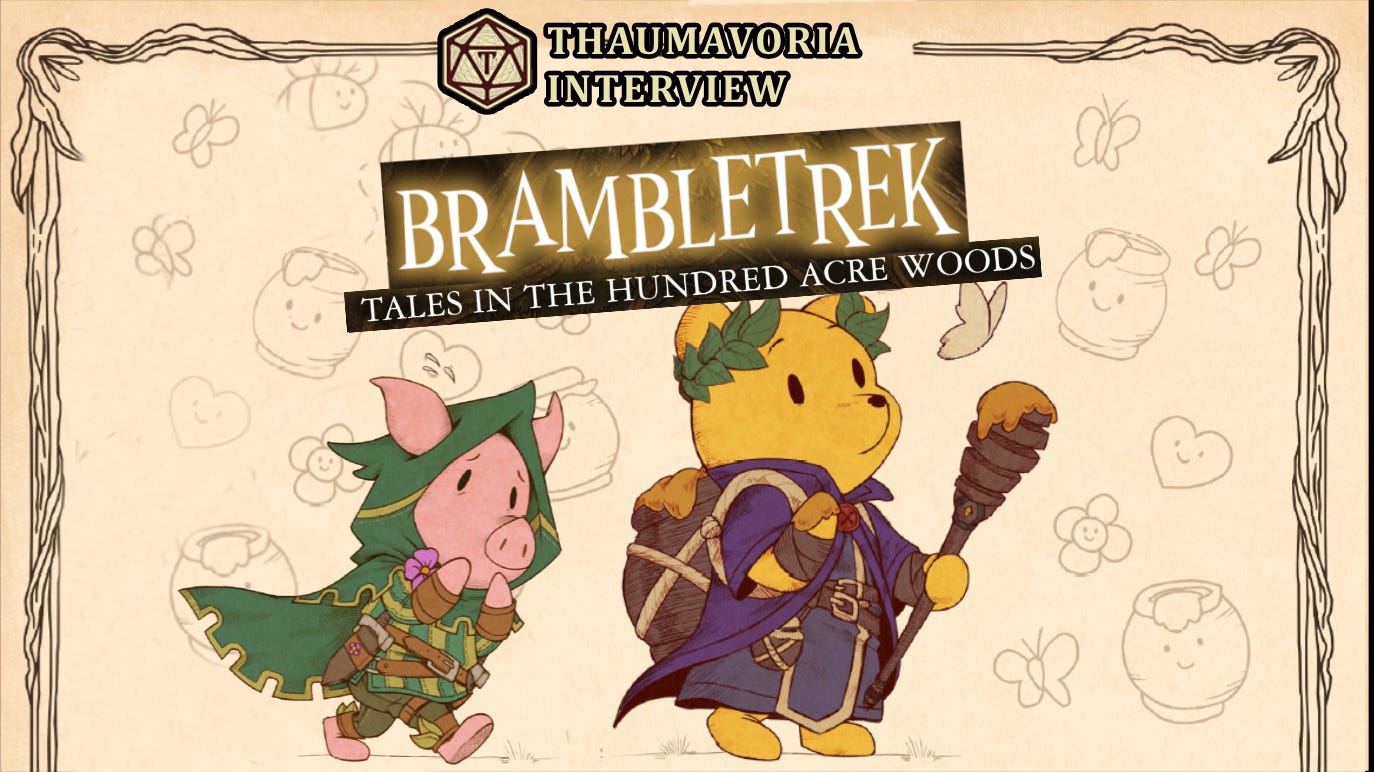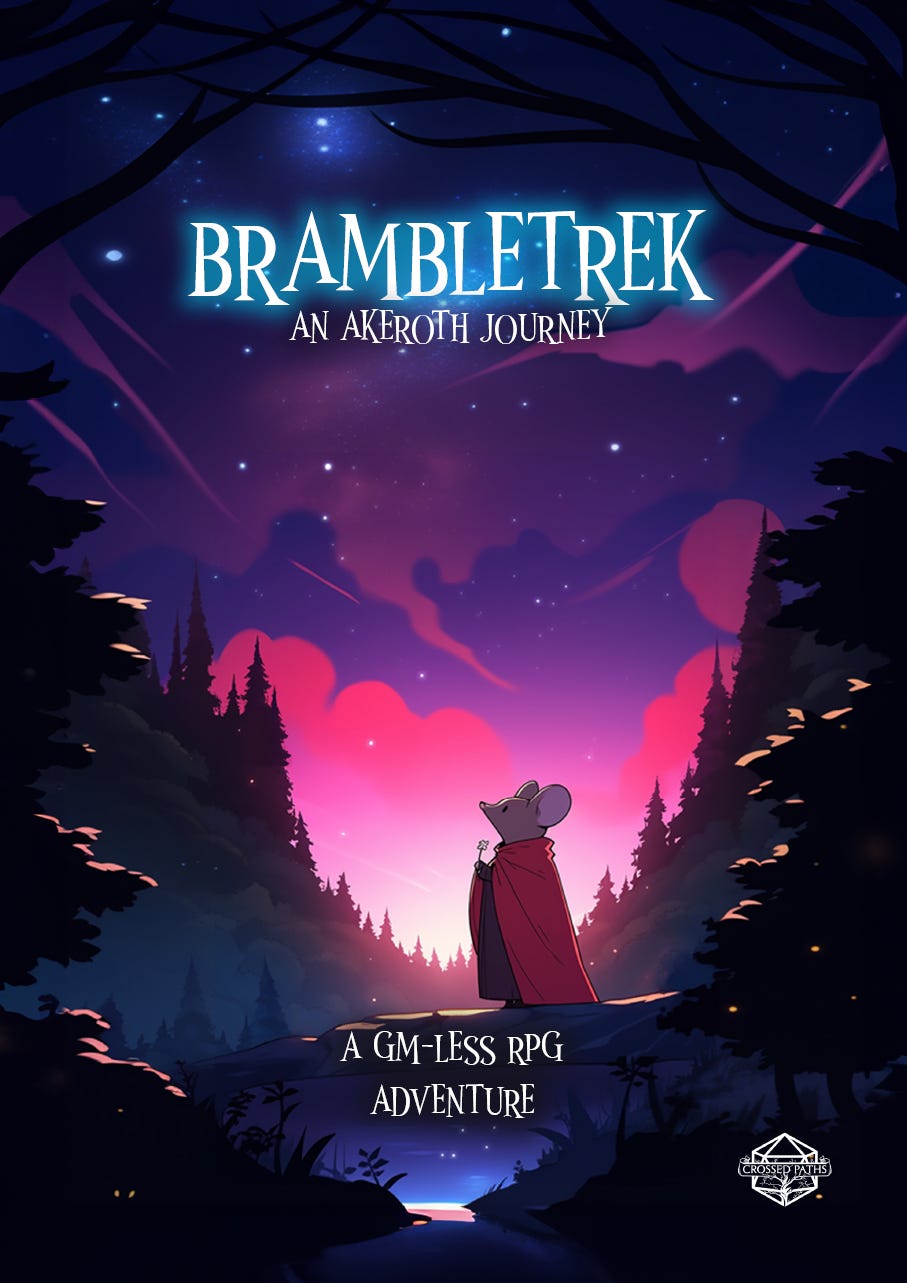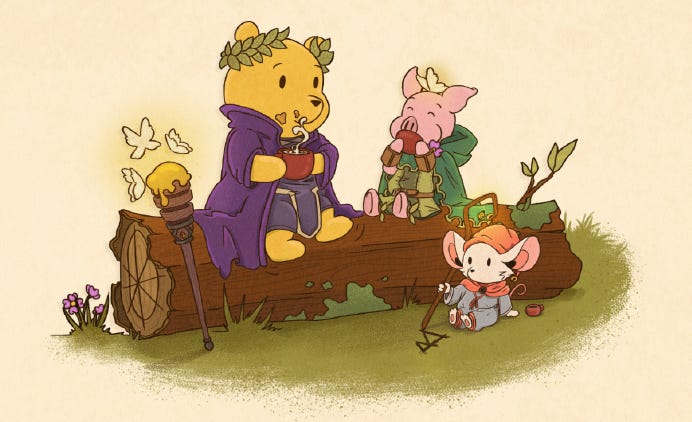Pooh Goes Solo—No Death, Just Naps
Creator Ash Swain explains Why Gentle Combat And Resource Management Elevate The Hundred Acre Wood
Brambletrek: Tales in the Hundred Acre Woods links:
Back Brambletrek: Tales in the Hundred Acre Woods
Watch my First Look video on this Pooh RPG. Does it Pooh?
Hi Ash, can you introduce yourself and tell us about your connection to tabletop RPGs?
Hey Dave! I'm Ash R. Swain, the creator of Crossed Paths Press. I specialise in designing GM-Less adventures that can be played solo or with a wider group! My first touch into TTRPGs is much like a lot of people where I jumped into 5th Edition during the pandemic. I was actually trying to buy Risk but it was sold out so instead I picked up the Lost Mines of Phandelver Starter Set!
Brambletrek
What inspired you to create a solo-focused journaling RPG like Brambletrek instead of a traditional GM-led format?
I was sitting there during a cancelled D&D session and wondered if there was anything I could do in the meantime that solved my itch for adventure but didn't require me to set up things like a board game and I delved into the world of Solo RPGs but Brambletrek literally arrived because I wanted to write a game for my son that we could play together when he was older. Something super simple in its rules but also didn't treat a younger audience like they wouldn't understand a deeper ruleset if given the chance.
The ruleset, which you call the Talebinder Game System, is built for solo and collaborative play using a deck of playing cards. How did you balance the introspective, narrative focus of Brambletrek with the randomness of card-based events?
Card draws are meant to be a framework that shapes a player's day and challenges but I never intended them to be rigid, the idea is any two people can draw the exact same set of cards but have wildly different experiences when journaling. The game has a freedom of choice that allows players to layer their creativeness over my framework for a unique experience every time.
The guided campaigns Pumpkin Party and Warmth of the First Frost are both centered around an annual festival. How did you keep them from feeling repetitive?
If you're like me then Christmas with the family, while familiar, evolves with each year. Things change, people grow and life happens around you. My goal with these expansions is to adapt that cyclical nature of tradition while approaching the core themes at a different angle. All my games release with 2 years of Seasonal Expansions guaranteed for free so I try to keep it somewhat fresh by tweaking expectations of what the festivals mean. For example one year the Frost festival may mean bonding with your Brushtail Cousins while another year you explore the frozen lakes in search of that one Acorn your family needs to make dinner.
In my first playthrough of Brambletrek, I stayed as close to the table entries as possible when drawing cards. But as you say here and in the books, the card draw results are only suggestions if you want them to be. How much creative license do you take when playing the game and interpreting your card results?
Oh, I take as much creative liberty as my brain allows, the game runs on a Rules as Understood basis, if you and your table agree that your understanding of a prompt/action is reasonable then that can be what happens. If a result sparks a new idea or I can adapt it to better fit my narrative then I will change it slightly while keeping the core themes. Brambletrek is a personal journey, so I want players to feel empowered to bend the prompts to fit their tone and direction.
A Winnie the Pooh RPG
What convinced you that Winnie the Pooh’s universe was a fit for the Brambletrek system?
I have always loved Winnie the Pooh and the Hundred Acre Wood has always been a place of exploration, friendship and adventure, it just felt right to align that with Brambletrek. The game thrives on introspection and small, meaningful moments—exactly the kind of storytelling that suits Pooh and his friends. It felt like a natural fit to adapt the mechanics for a world where curiosity, kindness and wild imagination shape the journey!
What were your biggest artistic or thematic influences for the Hundred Acre Woods portion beyond Milne’s text?
I'm not A.A Milne, the original author, nor will I pretend to capture his style of writing. There is a beautiful quote from one of his books that says "The things that make me different are the things that make me." This quote was one of my core inspirations, I realised I could write my own interpretation of his books and keep the core messaging alive. Artistic inspirations came from pastoral storytelling, the cozy bedtime stories you get told as a child and just nostalgia. It's meant to be whimsical and fun!
How did the artists Marta Kowalczewska and Jan Cruz handle the potential overlap between Disney’s visual style and the purely public-domain Pooh material?
These two are a pair of the most talented artists I have ever had the pleasure of working with but also am lucky to be able to call them good friends. They just started off by vetoing specific design ideas when we felt they strayed too close to Disney, we focused on E.H Shepard as the only real focus. This keeps the aesthetic distinct while still feeling nostalgic.
How did you adapt Pooh’s famously gentle tone to incorporate resource management and occasional combat?
They still live in a forest and we've definitely seen scenarios where they collect items or gather food for dinner so it wasn't too hard to implement that idea into this. As for the combat, the focus was less "defeat this" and more "they've been cursed" so the theme is more about saving your fellow forestfolk, although they do damage to your "health" - Health is just how tired you are and not your actual life. Players in this game can't "die" instead they just draw on a scenario table that tells them how they get back up and back to adventure.
Did you ever consider removing combat altogether in the Pooh expansion to keep the vibe friendlier?
Yes and combat is optional so if you wanted you could do away with it all together but the key drive was to not change Brambletrek's mechanics so that old and new players alike could journey on together without one feeling like they had to pick up new things just to play. The goal was to ensure conflict remained soft and optional.
How did you decide on which Pooh characters to slot into each of what are essentially the D&D classes?
You know what, I just felt it out. I know that's a cop out answer but there wasn't a huge meeting or planning, I just felt like Pooh would make a great druid and Roo would be an amazing Ranger.
The Misty Hollow parallels Pooh’s dreamlike innocence. How’d you refine that mechanic for the Pooh expansion?
The Hundred Acre Woods is meant to be a dreamlike place of wonder and hope but what happens when Christopher Robin has a nightmare, where do they go? That was what eventually became The Misty Hollow and the idea was that it's a reflection of the woods where fear goes and also explains why not a lot of bad things happen in the woods. They happen here instead. The mechanics around it's exploration are also a huge shift for Brambletrek as I've never introduced any real "exploring" or "crawl" systems so this was a good chance to test that idea while making the game a bit more tactile.
Have you introduced any new random events or prompts unique to Pooh that wouldn’t fit in your other Brambletrek campaigns?
All the prompts try their best to focus on the world of Pooh and it's inhabitants but the game's themes are designed in a way that nothing is "incompatible" per se but instead just different so you could go from helping Pooh cross a river to then returning to Hyhill and diving into the Dungeons of Dragonkeep without the story feeling disconnected. You act as that bridge.
What do you think new fans of Pooh will find most captivating about Brambletrek’s card-driven randomness?
The way the cards create unexpected but delightful twists in the narrative. The joy of Brambletrek is that you never quite know what will happen next, just like in Pooh’s adventures. The randomness encourages playful storytelling—turning a rainy day into a grand expedition or a missing honey pot into a mystery.
Community and Future
Is there a third-party license that allows other creators to publish their own guided adventures or expansions for Brambletrek?
There is, we hope to iron-out some of the more difficult legal stuff but at its core anyone can make whatever they want using our system just need to avoid utilising our copyrighted IP that isn't attached to the SRD.
Beyond Winnie the Pooh, are there other beloved literary worlds you’re keen to adapt into Brambletrek expansions?
A huge amount, we're actively developing a few now and although I can't talk about them, all I can say is one is particularly mad.
What else do you hope to explore with your publishing label Crossed Paths?
I just want to keep writing the games I find interesting and fun to explore. Whether it’s through journaling RPGs, narrative-driven tabletop experiences, or expansions that bring new perspectives to existing worlds, Crossed Paths is about crafting stories that stay with people while keeping to my ethos of writing what I enjoy rather than what the latest trend is.
Brambletrek: Tales in the Hundred Acre Woods links:
Back Brambletrek: Tales in the Hundred Acre Woods
Watch my First Look video on this Pooh RPG. Does it Pooh?













I love It! Super cute and sounds intriguing